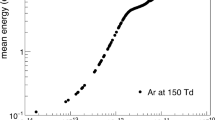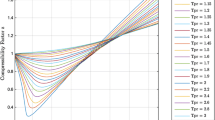Abstract
A model of thermodynamics of a reacting mixture of rarefied gases and a suspension of condensed species is developed by using statistical physics methods. An NVT ensemble is considered for determining the detailed equilibrium chemical composition, and the minimum of the free energy of the mixture of possible species is found numerically. Tabular data for the species are used for determining the enthalpy and free energy of chemical compounds. An algorithm that allows the Chapman–Jouguet detonation parameters to be determined for a wide range of combustible mixtures is developed. The model is tested through comparisons of the predicted and experimental detonation velocities. Good agreement for mixtures with oxygen excess is demonstrated. For compositions with the formation of a significant amount of condensed carbon, the predicted and experimental detonation velocities agree reasonably well.
















Similar content being viewed by others
REFERENCES
Yu. A. Nikolaev and M. E. Topchiyan, “Analysis of Equilibrium Flows in Detonation Waves in Gases," Fiz. Goreniya Vzryva 13 (3), 393–404 (1977) [Combust., Expl., Shock Waves 13 (3), 237–337 (1977)].
Thermodynamic Properties of Individual Substances, Ed. by V. P. Glushko, Vols. I–IV (Nauka, Moscow, 1978–1982) [in Russian].
Thermodynamic Properties of Individual Substances, Ed. by V. Iorish, Vols. V and VI; http://www.chem.msu.su/Zn.
G. V. Belov, S. A. Dyachkov, P. R. Levashov, et al., “The IVTANTHERMO-Online Database for Thermodynamic Properties of Individual Substances with Web Interface," J. Phys.: Conf. Ser. 946, 012120 (2018); DOI: 10.1088/1742-6596/946/1/012120.
“Thermodynamic Properties of Individual Substances. IVTANTHERMO Database." http://www. chem.msu.su/rus/handbook/ivtan.
NIST Chemistry WebBook, NIST Standard Reference Database Number 69, Ed. by P. J. Linstrom and W. G. Mallard; DOI: 10.18434/T4D303; https:// webbook.nist.gov/chemistry.
Facility for the Analysis of Chemical Thermodynamics (FACT); https://www.factsage.com.
Computer Program for Calculation of Complex Chemical Equilibrium Compositions and Applications; https://cearun.grc.nasa.gov.
G. Sanford and B. McBride, “Computer Program for Calculation of Complex Chemical Equilibrium Compositions and Applications," Tech. Rep. NASA (1994); https://ntrs.nasa.gov/citations/19950013764.
L. D. Landau and E. M. Lifshits, Theoretical Physics, Vol. V: Statistical Physics, Part 1 (Fizmatlit, Moscow, 2001; Pergamon Press, 1980) [in Russian].
D. Stull, E. Westrum, and G. Sinke, The Chemical Thermodynamics of Organic Compounds (Wiley, New York, 1969).
GNU Scientific Library Reference Manual, Ed. by M. Galassi et al.(2009); ISBN 0954612078; http://www.gnu.org/software/gsl.
A. A. Vasilev, A. I. Valishev, and V. A. Vasilev, “Detonation Hazards of Hydrogen Mixtures," in Proc. of the Colloq. on Gas, Vapor, Hybrid and Fuel–Air Explosions, pp. 392–395 (1998).
H. J. Michels, “Marginal Detonation in Hydrocarbon–Oxygen mixtures," Ph.D. Theses (Imperial College of Science, Technology, 1967).
H. J. Michels, G. Munday, and A. R. Ubbelohde, “Detonation Limits in Mixtures of Oxygen and Homologous Hydrocarbons," in Proc. Roy. Soc. A 319, 461–477 (1970).
H. G. Wagner, “Soot Formation in Combustion," in Proc. 17th Symp. (Int.) on Combustion (The Combustion Inst., Pittsburgh, 1979), pp. 3–19.
K. J. Dorge, F. Stephan, and H. G. Wagner, “Acetylene Detonations Hear the Upper Limit of Detonability," in Proc. 17th Int. Colloquium on the Dynamics of Explosion and Reactive Systems (ICDERS-1999), July 25–30. Univ. Heidelberg IWR, 1999.
I. S. Batraev, A. A. Vasil’ev, V. Yu. Ul’yanitskii, et al., “Investigation of Gas Detonation in Over-Rich Mixtures of Hydrocarbons with Oxygen," Fiz. Goreniya Vzryva 54 (2), 89–97 (2018) [Combust., Expl., Shock Waves 54 (2), 207–215 (2018).
J. Breton, Recherches Sur la Detonation des Melanges Gazeux: Theses Faculte des Sci. (Univ. Nancy, 1936).
A. A. Vasil’ev and A. V. Pinaev, “Formation of Carbon Clusters in Deflagration and Detonation Waves in Gas Mixtures," Fiz. Goreniya Vzryva 44 (3), 81–94 (2008) [Combust., Expl., Shock Waves 44 (3), 317–329 (2008)].
G. Munday, A. R. Ubbelohde, and I. F. Wood, “Marginal Detonation in Cyanogenoxygen Mixtures," Proc. Roy. Soc. A 306 (485), 179–184 (1968).
Author information
Authors and Affiliations
Corresponding authors
Additional information
Translated from Fizika Goreniya i Vzryva, 2021, Vol. 57, No. 5, pp. 74-85.https://doi.org/10.15372/FGV20210507.
Rights and permissions
About this article
Cite this article
Pruuel, E.R., Vasil’ev, A.A. Equation of State of Gas Detonation Products. Allowance for the Formation of the Condensed Phase of Carbon. Combust Explos Shock Waves 57, 576–587 (2021). https://doi.org/10.1134/S0010508221050075
Received:
Published:
Issue Date:
DOI: https://doi.org/10.1134/S0010508221050075




